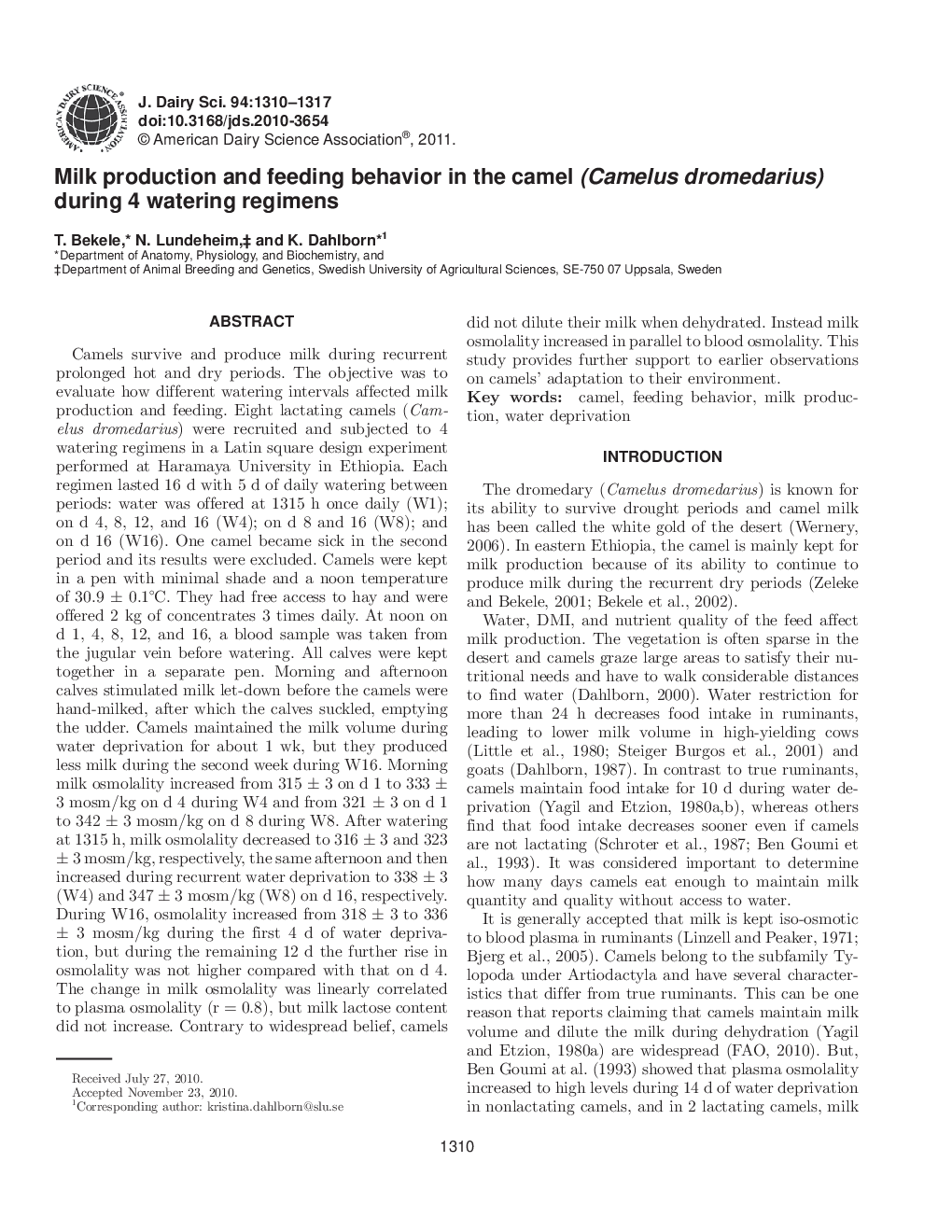| کد مقاله | کد نشریه | سال انتشار | مقاله انگلیسی | نسخه تمام متن |
|---|---|---|---|---|
| 10981391 | 1108076 | 2011 | 8 صفحه PDF | دانلود رایگان |
عنوان انگلیسی مقاله ISI
Milk production and feeding behavior in the camel (Camelus dromedarius) during 4 watering regimens
دانلود مقاله + سفارش ترجمه
دانلود مقاله ISI انگلیسی
رایگان برای ایرانیان
کلمات کلیدی
موضوعات مرتبط
علوم زیستی و بیوفناوری
علوم کشاورزی و بیولوژیک
علوم دامی و جانورشناسی
پیش نمایش صفحه اول مقاله

چکیده انگلیسی
Camels survive and produce milk during recurrent prolonged hot and dry periods. The objective was to evaluate how different watering intervals affected milk production and feeding. Eight lactating camels (Camelus dromedarius) were recruited and subjected to 4 watering regimens in a Latin square design experiment performed at Haramaya University in Ethiopia. Each regimen lasted 16 d with 5 d of daily watering between periods: water was offered at 1315 h once daily (W1); on d 4, 8, 12, and 16 (W4); on d 8 and 16 (W8); and on d 16 (W16). One camel became sick in the second period and its results were excluded. Camels were kept in a pen with minimal shade and a noon temperature of 30.9 ± 0.1°C. They had free access to hay and were offered 2 kg of concentrates 3 times daily. At noon on d 1, 4, 8, 12, and 16, a blood sample was taken from the jugular vein before watering. All calves were kept together in a separate pen. Morning and afternoon calves stimulated milk let-down before the camels were hand-milked, after which the calves suckled, emptying the udder. Camels maintained the milk volume during water deprivation for about 1 wk, but they produced less milk during the second week during W16. Morning milk osmolality increased from 315 ± 3 on d 1 to 333 ± 3 mosm/kg on d 4 during W4 and from 321 ± 3 on d 1 to 342 ± 3 mosm/kg on d 8 during W8. After watering at 1315 h, milk osmolality decreased to 316 ± 3 and 323 ± 3 mosm/kg, respectively, the same afternoon and then increased during recurrent water deprivation to 338 ± 3 (W4) and 347 ± 3 mosm/kg (W8) on d 16, respectively. During W16, osmolality increased from 318 ± 3 to 336 ± 3 mosm/kg during the first 4 d of water deprivation, but during the remaining 12 d the further rise in osmolality was not higher compared with that on d 4. The change in milk osmolality was linearly correlated to plasma osmolality (r = 0.8), but milk lactose content did not increase. Contrary to widespread belief, camels did not dilute their milk when dehydrated. Instead milk osmolality increased in parallel to blood osmolality. This study provides further support to earlier observations on camels' adaptation to their environment.
ناشر
Database: Elsevier - ScienceDirect (ساینس دایرکت)
Journal: Journal of Dairy Science - Volume 94, Issue 3, March 2011, Pages 1310-1317
Journal: Journal of Dairy Science - Volume 94, Issue 3, March 2011, Pages 1310-1317
نویسندگان
T. Bekele, N. Lundeheim, K. Dahlborn,